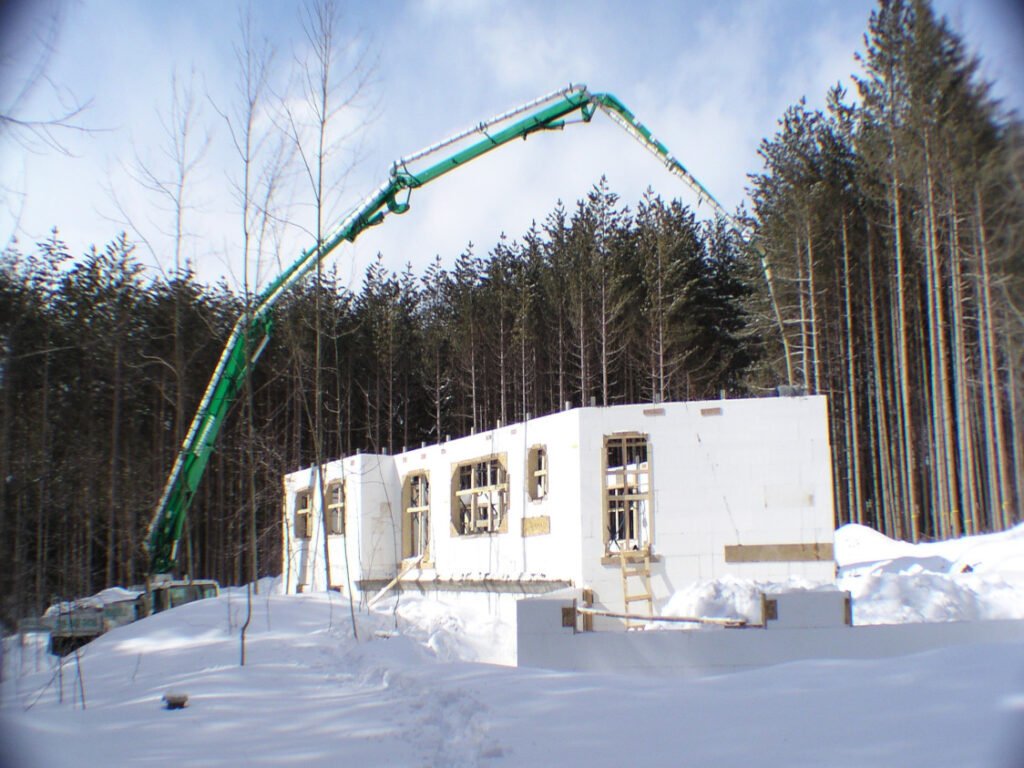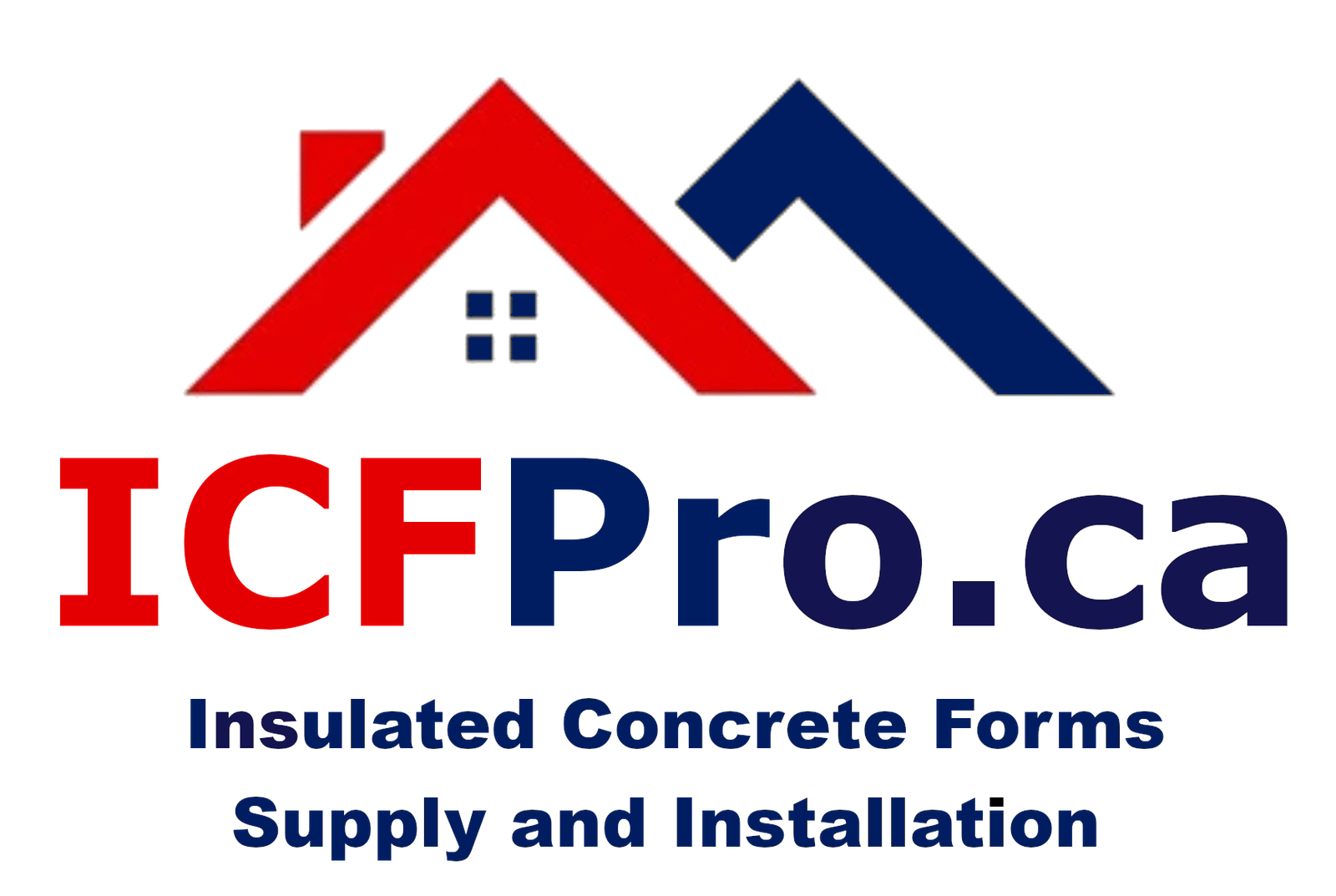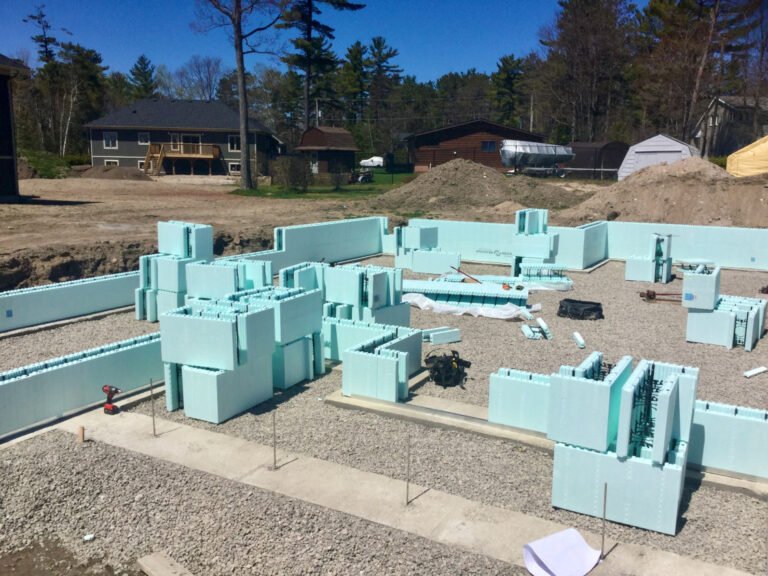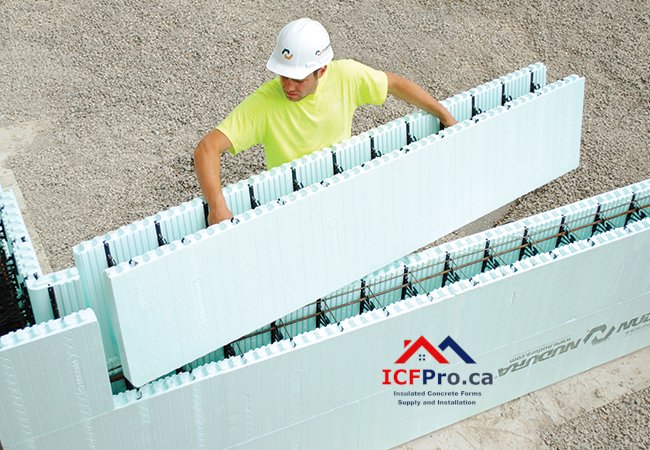ICFPro.ca is a division of ICFhome.ca - Phone 1 866 868-6606 - Direct Line 1 705 533-1633 - Email: info@icfhome.ca
From Basics to Brilliance: How to Build with Insulated Concrete Forms Made Easy

Who knew building could be as fun as a game of Tetris? Well, welcome to the delightful chaos of constructing with insulated concrete forms (ICFs). Let’s dive into their playful puzzle-piece nature and see why they might be your wallet’s new best friend.
Intro to ICF Construction
Picture this: constructing your dream home, not just by the traditional brick or stick, but with the exciting world of insulated concrete forms (ICFs). These giant block-like structures stack up like super-sized Legos, only instead of building a castle that tumbles at the first breeze, you’ve got walls that could withstand a good huff and puff from any wolf.
Stack some foam blocks, throw in a bit of rebar, and pour in the concrete! Voila, you’ve got yourself a rock-solid, energy-saving masterpiece. It’s practically turning your house into a fortress that’s cozy in winter, cool in summer, and quiet all year round.
With ICFs, you’re not just stacking blocks—you’re stacking up benefits. Bid farewell to breezy drafts and say hello to a home that’s as snug and solid as a bear hug. It’s like getting a cozy sweater you never have to take off—and you won’t even mind wearing it all year.
Cost Efficiency of ICFs
Now, let’s chat money—because who doesn’t like hearing how to save a few bucks? At first, you might think these clever building blocks cost a pretty penny, but let’s not jump to conclusions.
When you look at the price tag of insulated concrete forms, it’s like buying a smart car: sure, it might cost a bit more upfront, but think of all the gas money you’re saving! ICFs slash your utility bills and downplay maintenance repair like a pro tightrope walker.
Not only are you getting energy savings, but you’re also zipping through construction like the Flash. Compared to your run-of-the-mill concrete masonry units (CMU) or steel studs, ICFs are the underdog champion, especially for those big office buildings, schools, or any place where you don’t want to hear your neighbors’ rendition of rock classics.
Think of ICFs as the cool new buddy that’s always got your back—keeping your construction wallet-friendly while still giving you all the bang for your buck. Ready to build the fortress of your dreams that’s lighter on your pocket and kind to the planet? ICFs are here to make it happen, block by block!
Advantages of Insulated Concrete Forms
If you’ve ever wondered how to build using insulated concrete forms (ICFs), you’re in for a treat. Forget the usual building hassles—these ICFs are like the unsung heroes in construction, offering energy savings and turning down the volume on outside noise. They’re the rockstars of the building arena.
Energy Efficiency Benefits
Let’s talk energy savings. ICFs aren’t just playing the same game as regular wall methods like CMU, steel studs, or wood—nope, they’re in an entirely different league. We’re talking up to 20% energy savings in toasty places and a jaw-dropping 50% or more when Jack Frost is biting. With an insulation value of R25, ICF walls are like wrapping your house in a snuggly winter coat that’s been dipped in eco-friendly wizardry (CRMCA).
Compare these to wood-frame walls and you’ll see a 58% bump in R-value. That translates to keeping an extra 43% of that hard-earned money snug in your wallet. With ICFs, your heater and air conditioner can take a little vacation, giving you low energy bills and warm fuzzies about your sustainable choices.
Sound Reduction Capabilities
Now, let’s chat about noise—or the glorious lack thereof. ICF walls are like having a bouncer for sound. Starting with an STC (Sound Transmission Class) rating of 50 for the slim 4-inch walls, they can even reach a surprisingly quiet STC 70 when beefed up with thick walls and some extra gypsum pizzazz. It’s the difference between your home sounding like a library or a heavy metal concert.
So, energy efficiency that reduces bills alongside sound reduction that saves your sanity. For those diving into the world of home-building, ICFs make for a sound (pun intended) decision. You’re not just getting walls; you’re crafting a cozy, environmentally conscious, and noise-canceling haven. Whether you’re scoping out ways to slice those utility bills, do your part for Mother Earth, or just want a little piece and quiet, ICFs are the way to go for builders and dreamers alike.
Construction Considerations for ICFs
When stepping into the fascinating world of building with insulated concrete forms (ICFs), there are some life-saving details to keep in mind. In this section, we’re diving into the nitty-gritty of two important ingredients for ICF success: wall thickness and fire resistance. Let’s see how these factors play with energy efficiency too.
ICF Wall Thickness Options
Imagine your ICF walls like layers of a lasagna, but way less delicious. They come in sizes fit for whatever grand dreams you’re cooking up, from a skinny 4 inches to a hefty 12 inches. Picking the right thickness spells doom or success for the strength and brawn of your building.
- 4-inch walls: These guys hang back for lighter tasks, like being that awkward-silence cousin wall in apartments, hotels, or dormitories (Check out these wall party planners—CRMCA).
- 6 inches and up: Now, you need muscle for the heavy lifting. Walls this thick mean business and keep everything standing through thick and thin.
Picking the thick-walled hero for your project is a game-changer. Builders and engineers? It’s your mission to pick just the right thickness for the plans you’ve drawn up.
Fire Resistance and Energy Performance
ICF walls? They’re like the firefighters of the construction world, all strong and protective. They thumb their noses at fire, offering more safety than your grandma’s knitted sweater. Most hit a solid 2-hour fire rating for their slender 4-inch form, while the beefier sorts pass a 4-hour rating. To avoid any eyebrow-raising at safety sign-offs, a standard practice is slapping on a 1⁄2-inch gypsum sheet, because nobody wants surprises in that department.
Let’s talk energy. ICF walls are the caffeine shot your energy bills never saw coming. They laugh in the face of CMUs, steel, and wood studs, keeping warmth in or out like they’ve got something to prove. In summer sweat or winter chill, these walls cut energy use by 20% to over 50%, depending on how grumpy the weather is. With insulation values flaunting around R25, these walls are as close to magic as you’re gonna get, promising green wonders for your wallet and the world (CRMCA).
Fusing wall thickness, fire resistance, and top-notch energy-frugality, ICFs are your ticket to raising solid, smart, and earth-hugging builds. So, with a bit of knowledge and savvy planning, crafting with ICFs goes beyond mere construction—it’s about leaving your mark with buildings that stand the test of time, and maybe gravity. And let’s face it, who doesn’t want to be known as the legend who conquered the world of ICFs?
Practical Benefits of ICFs
Building stuff nowadays ain’t just bricks and mortar, it’s all about insulated concrete forms (ICFs) – the cool kids of construction. Why? They cut down build time and don’t crumble when Mother Nature throws a tantrum.
Time-Saving Construction
Ever wish you could speed up building your dream house? Well, ICFs might just be your answer. According to New House Builder, you could shave 2-4 months off build time. Imagine eating pizza faster! ICFs skip all the faff of waterproofing wood frames, making life easier for builders.
ICFs also give a little wink to cold weather. Their insulating magic helps concrete set nicely even when Jack Frost is nipping at your nose. So, no more waiting for spring to get things going! If you’re into knowing how much green you’ll save alongside time, head over to our piece on the cost of insulated concrete forms.
Disaster Resistance and Durability
ICFs are like that hero standing firm in the eye of a storm. These bad boys have faced hurricanes like Dorian and Michael and even California’s wildfires, coming out tougher than ever (New House Builder).
ICF walls don’t back down. Built to resist winds over 200 mph, they’re like the Rocky Balboa of walls. They stand strong against flying debris too, which means less cleanup and more peace of mind. Research shows they’re mightier than traditional walls – take that, plywood!.
Now, talk thickness. ICF walls have a 6” concrete core making them around 11.5” thick, while the 8” core beefs up to about 13.5”. Compare that to your run-of-the-mill walls, and you’ve got yourself a fortress.
Swap out the old for something that’ll save you time and stand the test when nature throws curveballs. With ICFs, you’re not just building – you’re creating a powerhouse of a home. Discover what these game-changing forms can do, and maybe, just maybe, you’ll be the next construction trendsetter.
Environmental Impact of ICFs
Ah, insulated concrete forms (ICFs), the underappreciated superheroes of building materials. They’ve got eco-conscious vibes written all over them, and they’re here to make sure Mother Earth gets a little more love. If you’re looking to shrink that pesky carbon footprint of yours, well, let me introduce you to these nifty building blocks. Not only are they helping the Earth breathe easier, but they’re also pretty tidy—producing less trash during construction.
Sustainability of ICF Construction
Imagine you’re building a cozy little hideaway; ICFs are like wrapping it in a snug thermal blanket, keeping that place comfy year-round as Fox Blocks points out. These energy-whizzes save you from using your heater or AC too much, which means less energy burned and fewer carbon whooshes into the air. So, yeah, they’re saving the planet one carbon emission at a time. But wait, there’s more! Around 60% of what makes up these ICF blocks is recycled stuff. It’s like they’ve taken recycling to a whole new level, promoting a loop-the-loop economy that wants to give a second life to materials otherwise destined for the dump.
Reduced Construction Waste
The mess left behind in the wake of construction can make you want to pull your hair out, right? Well, not with ICFs. They have this neat trick where they hardly leave any leftovers, unlike the messier wood-frame options as Alleguard suggests. Think of ICFs as the fastidious friend who knows how to tidy up after themselves, leaving almost nothing for the landfill to feast on. It’s a win for green building ideals, inching us closer to a planet where waste is as rare as a unicorn.
When you opt for ICFs, you’re not just basking in energy-efficient comfort and undeniable toughness—you’re also championing eco-friendly innovation. So, for modern builders and fresh homeowners craving to make a responsible choice with zero sacrifice on comfort and durability, putting your bet on ICFs is, well, a classic no-brainer.
ICF Installation Tips
So, you’re thinking about diving into the action-packed adventure of building with Insulated Concrete Forms (ICFs), eh? Well, strap on your hard hat because having a rock-solid game plan is key to nailing a top-notch build. Here’s how you can lock in all that construction know-how especially when dealing with foundations and keeping the wet stuff out and off.
Foundation Building with ICFs
If you’re planning to kick things off with a bang—laying those ICF foundations correctly is practically the secret sauce to ensuring your construction doesn’t fall apart like a cheap piñata. It usually takes about a week to set the base for a cozy home sweet home after you’ve given the footings a good pat down.
Here are some tips that might save you a tantrum or two:
- Get those ICF blocks lined up like bouncers at a club—firm and aligned. Make sure those pieces lock together snugly.
- Be OCD: keep those walls even, and the ICF forms should sit in symmetry.
- Don’t skimp on the support crew! The strengtheners that run vertically and horizontally add the muscle your walls need.
- Stuck? It’s not madness to call in the pros or flip through a tech guide.
Foundation done right means your construction’s spine won’t crumble—keeping it standing tall and proud.
Waterproofing and Protective Measures
Thinking about how water might sneak in and mess up the new digs? That’s being one step ahead, my friend. Without proper measures, your ICF home might just turn into a not-so-desirable indoor swimming pool. Fear not, though! Here are some handy tricks:
- Apply a Waterproofing Membrane: Slap on a sturdy membrane on the ICFs’ outer layer like you’re frosting a cake. Consider something like Halo’s Subterra because, like an umbrella, it stops the drip, drip, drip tomorrow and the day after that (Element ICF).
- Incorporate Drainage Material: For a rain-stopping extravaganza, add six inches or so of drainage material over the weeping tile around the foundation. It’s like giving a thumbs-up to water flow control, steering it well away from your prized structure.
Follow these tips and you won’t just be keeping water out. You’ll be securing your fortress like the professionals do, ensuring it’s not just habitable but a bona fide comfort zone. ‘Cause let’s face it—a dry and cozy home is everyone’s idea of the dream.



